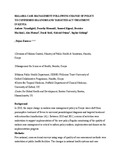MALARIA CASE-MANAGEMENT FOLLOWING CHANGE OF POLICY TO CONFIRMED DIAGNOSIS AND TARGETED ACT TREATMENT IN KENYA

View/
Date
2013Author
Zurovac, Dejan
Githinji, Sophie
Otieno, Gabriel
Soti, David
Muturi, Alex
Machini, Beatrice
Kigen, Samwel
Memusi, Dorothy
Nyandigisi, Andrew
Type
PresentationLanguage
enMetadata
Show full item recordAbstract
Background:
In 2010, the major change in malaria case-management policy in Kenya was a shift from presumptive treatment of fevers to universal parasitological diagnosis and targeted treatment with artemether-lumefantrine (AL). Between 2010 and 2012, a series of activities were undertaken to support implementation of the new policy.Regular monitoring of the quality of malaria case-management is critical to inform policy makers, implementers and donors on the implementation progress.
Methods:
Five national, cross-sectional surveys using range of quality-of-care assessment methods were undertaken at public health facilities. The changes in national health systems and case-management indicators between the baseline survey undertaken prior to the implementation of the new policy and four follow up surveys are measured.
Results:
The number of assessed facilities ranged between surveys from 172 to 176, interviewed health workers from 216 to 237 and evaluated outpatient consultations for febrile patients from 1,208 to 2,405. Compared to baseline
results, the health systems indicators showed improvements by the end of 2012: availability of malaria diagnostics increased from 55% to 76%, AL stock-out declined from 27% to 22%, access to new guidelines increased from 0 to 57%,
trained health workers from 0 to 26% and malaria supervision increased from 19% to 48%. In the same period, malaria testing increased from 24% to 47% while patients with fever who were both tested and treated according to the test
result improved from 16% to 39%.At facilities with AL and malaria diagnostics, malaria testing increased from
43% to 58% while those patients who were both tested and treated according to the test result increased from 28% to 48%. Treatment with AL for test positive patients improved from 83% to 93% while antimalarial treatment of test negative
patients declined from 53% to 22%. The performance results for other health systems and case-management indicators and trends over five survey rounds will be presented during the meeting.
Conclusions:
By the end of 2012, most of the key indicators have shown improvements however the changes were smaller than expected and for most indicators are still below the targets aiming at universal intervention coverage
and adherence practices.
Citation
Nyandigisi, Andrew Memusi, Dorothy Kigen, Samwel Machini, Beatrice Muturi, Alex Soti, David Otieno, Gabriel Githinji, Sophie , Zurovac, Dejan .Malaria case-management following change of policy To confirmed diagnosis and targeted act treatment In Kenya,2013Publisher
University of Nairobi School of Medicine
